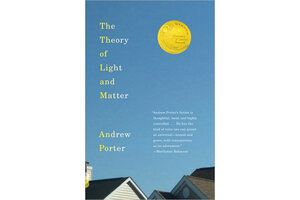The Theory of Light and Matter
Vulnerable, hopeful characters populate this award-winning collection of short stories.

Of all the things to love about The Theory of Light and Matter, Andrew Porter’s wonderful collection of short stories, my favorite is how tenderly his characters treat one another’s failings and vulnerabilities. Like outsiders looking in, one step removed from their own lives, Porter’s characters tread carefully in their quest toward understanding.
Such tenderness was a hallmark of minimalist master Raymond Carver – not a bad writer with whom to be compared. While Porter’s young characters haven’t yet fallen on the hard times that Carver’s have, their sensitivity is just as stirring and their subtle moments of epiphany just as poignant.
But where Carver’s tales tend to follow a linear projection, action rising to a climax, Porter favors a more circular route. His stories contain not just the retelling of what happened, but also the stories the narrators tell themselves long after: what it meant then, and what it means now.
Porter plays with the effect time has on memory. At times the reader may feel unmoored; after all, we’re hearing these stories from narrators who wanted things to have turned out differently.
In “River Dog,” a confused younger brother hears that his older brother, whom he idolizes, committed a reprehensible act against an unwitting girl. Still unable – or unwilling – to understand it, he later writes an essay about it in college, only to have the professor write across the front page: “The reader deserves to know what really happened.”
It’s a wonderful line on two levels: First, we assume the little brother, too, feels he deserves to know what really happened; but how can he tell the teacher something he doesn’t know?
But on another level, it’s a great line because one gets the sense that Porter, with his nonlinear approach to storytelling, has probably had those same words scrawled across his own stories – by teachers and perhaps by readers.
This inability to know and to tell what “really” happened seems to be precisely Porter’s point: The more we think about the past – about the moments that have come to define us – the more our memory reshapes them.
And, take this a step further, as Porter’s characters do: Is there a difference between what “really” happened and what we remember happening? Isn’t all the past created and shaped by memory anyway?
The title story, “The Theory of Light and Matter,” plays the most with memory. Flawlessly told in female first-person, this story won the prestigious Flannery O’Connor Award for Short Fiction.
A college student develops a platonic relationship with her physics professor, and years later, married to an “established” doctor named Colin, she looks back at the moments that defined that illicit relationship: “[T]here was, and would always be, a communication between us that went beyond words. I resented it at the time, how easily he seemed to understand me.” Ten years later, living a “not unhappy” life, she looks back wistfully at that earlier intimacy. She observes, “The part of me [the professor] fulfilled is a part which I imagine Colin, even now, doesn’t know exists.”
My favorite story, “Departure,” (winner of the Pushcart Prize) tells of two misfit high school boys who spend Friday nights at the town diner, watching their neighbors, Amish teenagers, arrive for a few hours of life in the fast lane.
The boys are appalled by the cruelty of their suburban classmates who taunt and fight the Amish youths. One boy, who is also the narrator, begins to “date” Rachel, an Amish girl who loves her weekly dose of reckless riding in the boys’ pickup truck and racing barefoot in the dark.
When Rachel’s family finally succumbs to developers who covet their farmland, the narrator quietly watches her go. Wisely he observes she probably wasn’t going to miss her forays into modern culture as much as she was going to miss her family’s homestead.
Years later he looks back: “We have new malls and outlet stores where their farms were, and out where Rachel used to live, actors dressed in Amish costumes and fake beards stand along the thruway, chewing on corncob pipes....
[W]hen I think about Rachel now, I think mostly about those races we used to have out across the railroad bridge, thirty feet above the water, and I still shudder at our carelessness, our blind motions, not watching where we were stepping, not even considering what was below us.”
This collection, originally published by University of Georgia Press, deserves to be read and reread. Porter teaches creative writing at Trinity University in San Antonio, Texas.
He is a master storyteller, a creator of tender and hopeful characters, a writer who whispers rather than screams his truths. We look forward to more from such an amazing talent.
Elizabeth A. Brown is a freelance writer living near Hillsborough, N.C.
